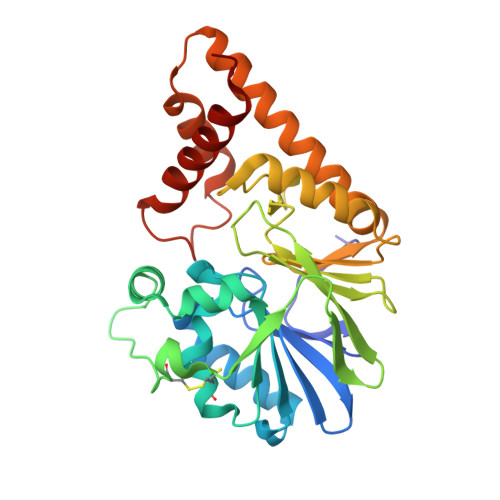Dissecting the Multiple Roles of PqsE in Pseudomonas aeruginosa Virulence by Discovery of Small Tool Compounds.
Zender, M., Witzgall, F., Drees, S.L., Weidel, E., Maurer, C.K., Fetzner, S., Blankenfeldt, W., Empting, M., Hartmann, R.W.(2016) ACS Chem Biol 11: 1755-1763
- PubMed: 27082157
- DOI: https://doi.org/10.1021/acschembio.6b00156
- Primary Citation of Related Structures:
5HIO, 5HIP, 5HIQ, 5HIS - PubMed Abstract:
Pseudomonas aeruginosa uses quorum sensing (QS) as a cell-to-cell communication system to orchestrate the expression of virulence determinants. The biosynthesis of the important Pseudomonas quinolone signal (PQS) requires the pqsABCDE operon. Here, PqsE acts as a pathway-specific thioesterase, but it also contributes to the regulation of bacterial virulence via an unknown mechanism. In this manuscript, we report the discovery of PqsE inhibitors as tool compounds to gain further insights into its different functions. Differential scanning fluorimetry (DSF) was used to screen a fragment library, and isothermal titration calorimetry (ITC) was employed as a secondary filter. As proven by X-ray crystallography, hit molecules bound to the active center inhibiting PqsE's thioesterase activity in cell-based and in vitro assays. Notably, the ligands did not affect the levels of the PqsE-regulated virulence factor pyocyanin. These findings indicate that the regulatory function of PqsE is not linked to its thioesterase activity and must be encoded outside of the active center. This study highlights the potential of fragment-based screening for the discovery of tool compounds. This approach provided novel insight into complex biological systems, which could not be obtained by knockout studies.
Organizational Affiliation:
Helmholtz Institute for Pharmaceutical Research Saarland (HIPS) , Department Drug Design and Optimization, Campus E8.1, 66123 Saarbr¨ącken, Germany.


















